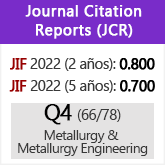Consistencia dimensional en cubos de sincronización de alto rendimiento
DOI:
https://doi.org/10.3989/revmetalm.1218Palabras clave:
Doble prensado y sinterizado, Control dimensional, Componentes de altas prestacionesResumen
Las tolerancias en componentes fabricados para la industria del automóvil son tan estrechas que cualquier modificación en las variables del proceso puede provocar que no se cumplan. Una disminución de las tolerancias dimensionales, puede significar una mejora en las propiedades de las piezas. Dependiendo de los requerimientos dimensionales y del material, distintas rutas de procesado pueden seguirse para encontrar un método de procesado robusto, que minimice costes y maximice la capacidad del proceso. En los últimos años, la tolerancia dimensional se ha ajustado gracias a métodos de procesado como el doble prensado/doble sinterizado (“2P2S”), método de gran precisión para conseguir estrechas tolerancias. En este trabajo, se muestra que los parámetros de procesado del primer ciclo de sinterización tienen una gran importancia en los pasos siguientes y en las dimensiones finales alcanzadas. Todos los ciclos se han realizado en una línea real de fabricación de cubos sincronizadores para cambio manual, asegurando el mantenimiento de condiciones estables y control de proceso relevante para el producto y el proceso en sí mismo.
Descargas
Citas
[1] D. Whittaker, Metal Powder Report 50 (1995) 14-24. http://dx.doi.org/10.1016/0026-0657(95)80018-2
[2] P. K. Johnson, Int. J. Powder Metall. 26 (1990) 57-61.
[3] P. Lindskog, Powder Metall. 47 (2004) 6-9.
[4] H. Danninger, Mater. Sci. Forum 426 (2003) 115-122. http://dx.doi.org/10.4028/www.scientific.net/MSF.426-432.115
[5] J.M. Torralba, R. Oro and M. Campos, Mater. Sci. Forum 672 (2011) 3-11. http://dx.doi.org/10.4028/www.scientific.net/MSF.672.3
[6] J. Tengzelius, U. Engstrom, "Means to improve the dimensional tolerances of steel components", in "Modern Development in Powder Metallurgy", Ed. Metal. Powder Industries Federation, Princeton, EE.UU., 1985, pp. 743-765.
[7] P. Lindskog, Powder Metall. 13 (1970) 280-294.
[8] G. Wastenson, Powder Metall . 18 (1975) 124-149.
[9] P. Lindskog, Materiaux et Techniques 64 (1975) 66-95.
[10] P.G. Arbstedt, "Alloy Systems Developed for Pressing and Sintering in the Ferrous Field", in Alloy Composition and Microstructure Control in Relation to Processing, Ed. Metals Society, London, 1975, p. 37.
[11] P. Lindskog and O. Thornblad, Powder Metal. Int. 11 (1979) 10-11.
[12] W.C. Zapata, J.M. Torralba and J.M. Ruiz. "Comparative study of Cu-Ni-Mo sintered steels obtained from elemental mix and prealloyed powders", in "Horizons of Powder Metallurgy", Part II. European Powder Metallurgy Federation, 1986, pp. 1053-1056.
[13] J.M. Ruiz, J.M. Torralba, J.L. Sánchez, C. Ranninger and W.C. Zapata, "Influence of Molybdenum on properties and microestructure of sintered alloyed steels", in "Sintering'87", Ed. Elsevier Applied Science, 1, 1988, pp. 677-682.
[14] J. Tengzelius, Rev Metall-Paris 85 (1988) 1007-1013.
[15] K.L. Narasimhan and J. Tengzelius, "P/M Low Alloy Steels--Alloying Methods and Continuous Improvement", in "Advances in Powder Metallurgy & Particulate Materials". Ed. Metal Powder Industries Federation, Princeton, EE.UU., 1992, pp. 153-172.
[16] C.M. Sonsino, J. Tengzelius, V. Arnhold, K. Lipp, R. Wahling and E. Hoffmann, in "Advances in Powder Metallurgy & Particulate Materials." Ed. Metal Powder Industries Federation, Princeton, EE.UU., 1992, pp. 115-125.
[17] F. Chagnon and M. Gagné, "Machining sinter hardenable P/M materials" Proceedings of the 1998 World Congress on Powder Metallurgy, Granada, Spain, 1998, pp. 384-389.
[18] J. Tengzelius, "Advances in Steel Powders for High Performance PM Parts", Proceeding of the Powder Metallurgy Conference, PMAsia 2005 Shanghai, 2005.
[19] M. Campos, L. Blanco, J. Sicre-Artalejo and J.M. Torralba, Rev. Metal. Madrid, 44 (2008) 5-12.
[20] B. Lindsley and T. Murphy, Mater. Sci. Forum, 534-536 (2007) 665-668. http://dx.doi.org/10.4028/www.scientific.net/MSF.534-536.665
[21] U. Engstrom, "Influence of sintering temperature on properties of low alloyed high strength PMmaterials", in "Advances in Powder Metallurgy & Particulate Materials", Ed. Metal Powder Industries Federation, Princeton, EE.UU., 2001, pp. 204–215.
Descargas
Publicado
Cómo citar
Número
Sección
Licencia
Derechos de autor 2013 Consejo Superior de Investigaciones Científicas (CSIC)

Esta obra está bajo una licencia internacional Creative Commons Atribución 4.0.
© CSIC. Los originales publicados en las ediciones impresa y electrónica de esta Revista son propiedad del Consejo Superior de Investigaciones Científicas, siendo necesario citar la procedencia en cualquier reproducción parcial o total.Salvo indicación contraria, todos los contenidos de la edición electrónica se distribuyen bajo una licencia de uso y distribución “Creative Commons Reconocimiento 4.0 Internacional ” (CC BY 4.0). Puede consultar desde aquí la versión informativa y el texto legal de la licencia. Esta circunstancia ha de hacerse constar expresamente de esta forma cuando sea necesario.
No se autoriza el depósito en repositorios, páginas web personales o similares de cualquier otra versión distinta a la publicada por el editor.


















